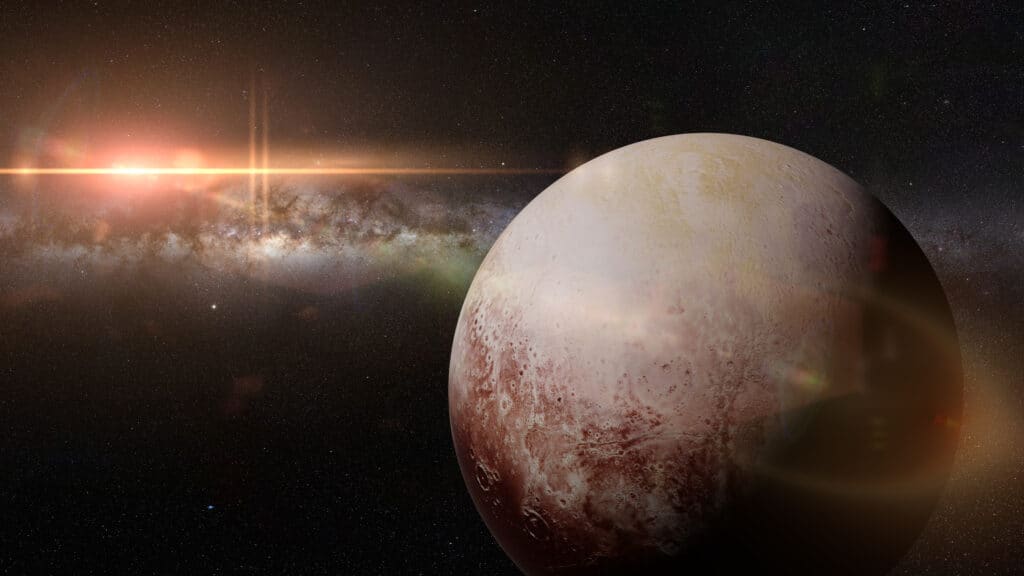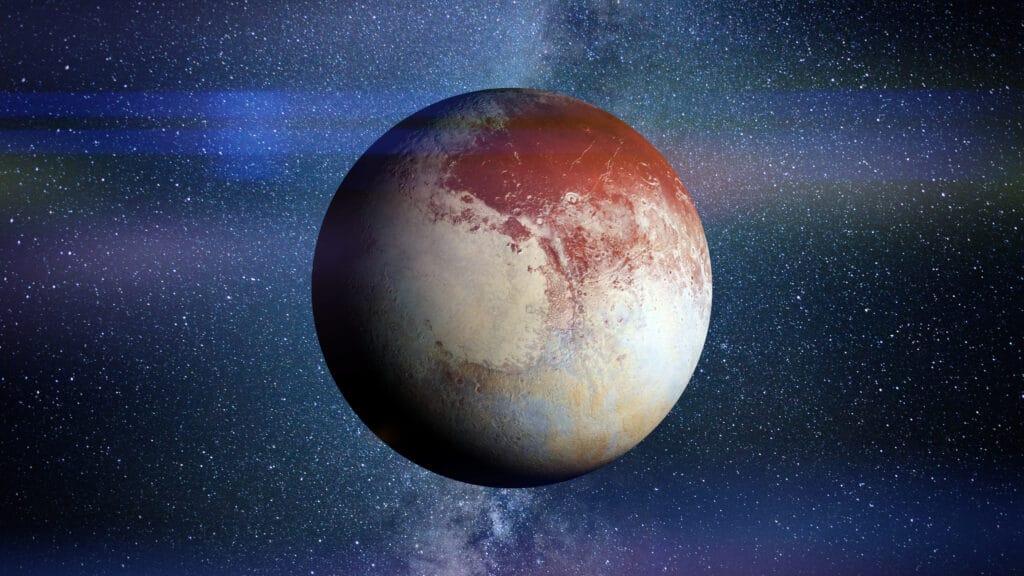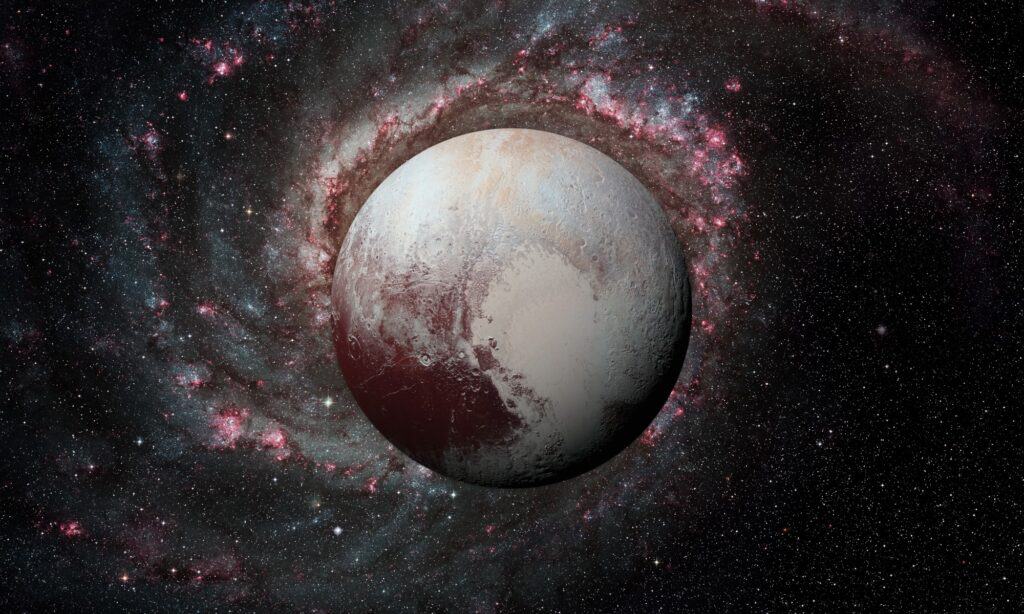Pluto can be found about 3.6 billion miles from the center of our Solar System. As a result, temperatures there are literally out of this world! This entity is the largest known body in the Kuiper belt (a ring of bodies located beyond Neptune’s orbit). As you probably know, Pluto is not an official planet and is characterized as a dwarf planet.
This scientifically mesmerizing body consists of rock and ice. This factor contributes to the low temperatures that can be experienced there. Another factor is the distance from the Sun. Even though light moves at 671,000,000 mph, it still takes up to five and a half hours for the Sun’s light to reach the dwarf planet.
Pluto is a cold planet. How cold, you might ask? Well, you’ll find the specifics below. All we can say for now is that its surface can get so cold that nitrogen freezes like water on Earth.
How cold is the surface of Pluto really?

According to NASA, the mean temperature of Pluto is -375 °F.
©iStock.com/dottedhippo
The average temperature of Pluto’s surface is about -370 to -400 °F. It is only about 60 °F away from absolute zero, making it extremely difficult for any type of organism to live there. The main reason for these low temperatures is the dwarf planet’s distance from the Sun.
When the dwarf planet is the closest to the Sun, its atmosphere turns into gas. At the same time, Pluto’s atmosphere freezes onto its surface as the body moves away from the Sun. Pluto also features an immense body primarily consisting of nitrogen ice. This body of ice made scientists believe Pluto may be hosting a 60-mile deep subsurface ocean. This resulted in theories suggesting that Pluto’s rocky core is surrounded by an ice ocean, on top of which sits an icy surface.
Most organisms wouldn’t resist such low temperatures. However, let’s not forget the well-known saying where’s water, there’s life.
According to NASA, the mean temperature of Pluto is -375 °F (mean temperature accounts for temperatures across the entire surface of this rocky dwarf planet).
What could survive on Pluto?

Organisms could survive such low temperatures on Pluto only in a cryogenic state.
©iStock.com/dottedhippo
Pluto’s surface is incompatible with life as we know it. No organism could survive the incredibly low temperatures on this planet. Even if water were present on the dwarf planet’s surface, it would be frozen and hard like a rock.
Even if we take into account the studies that suggest Pluto’s underground is actually an ocean, life still wouldn’t be possible there. Those studies show that the dwarf planet’s core might be surrounded by an ice ocean – water, but frozen. An icy surface is believed to stand between the mentioned ocean and the actual surface of the planet.
It is extremely difficult to determine whether organisms (alien organisms, for that matter) could actually live on Pluto. On the other hand, it’s certain that organisms known to people could never survive the dwarf planet’s surface, nor the transition to its presumably warmer (or colder, if we consider the theories regarding Pluto’s frozen ocean) inner ocean.
Organisms could survive such low temperatures only in a cryogenic state. This state, however, implies that they cannot evolve or develop. It is not a state that can be associated with living, but with the preservation of cells and molecules.
Could tomato plants or other vegetables/fruits survive on the surface of Pluto?
Tomato plants, other vegetables, and fruits couldn’t survive the incredibly chilling temperatures on the surface of Pluto. Most plants can take some frost but won’t survive freezing, while temperatures above 90 °F lead to wilting.
Given that Pluto’s surface temperature can drop to as low as -400 °F, it is clear that no living organism could survive there. Plants couldn’t grow beyond the seed status.
Could tardigrades survive on the surface of Pluto?
Tardigrades are microscopic organisms that survived being exposed to outer space. They are also believed to be able to survive the apocalypse, unlike humans. Tardigrades make for the most resilient organisms on our planet, as they can survive extremely harsh conditions. But could they survive the surface of Pluto?
Tardigrades can be found in an active or tun state depending on the temperature. In an active state, they can survive temperatures of up to 98 °F. In the tun state, they are more resilient and can survive temperatures as low as -328 °F. However, keep in mind that this tun state is characterized by a dried and lifeless appearance – much like hibernating, but more extreme.
Given the temperatures on the surface of Pluto, tardigrades couldn’t survive there in either of their states. Pluto is too much even for these tiny explorers of outer space.
Would water be frozen or liquid on the surface of Pluto?
Water would be rock-solid frozen on the surface of Pluto. It freezes at 32 °F, and at temperatures as low as -400 °F, its molecules would be so dense that water (ice, actually) would be extremely tough. At a point so close to absolute zero, any water form brought on Pluto (liquid or gas) would instantly freeze in this planet’s cold atmosphere.
Even though scientists are working on ways to keep water liquid at extremely low temperatures, it is unlikely that we’ll ever see it in a liquid state at -400 °F. At the moment, scientists managed to keep water liquid at temperatures as low as -49 °F – that’s approximately 351 degrees away from the temperatures on the surface of Pluto.
Are there any signs of life on Pluto?

There are no life signs on Pluto, be they past or present.
©NASA images/Shutterstock.com
There are no life signs on Pluto, be they past or present. The dwarf planet sits too far away from the center of our Solar System for any organisms to survive there. It has temperatures that could very well reach absolute zero in the distant future.
Regardless of the pressure, atmospheric conditions, and so on, any water body on Pluto would turn into a solid rock almost instantly.
The main characteristics of Pluto
| Volume | Mass | Surface gravity | Average surface temperature | Predominant composition element | |
|---|---|---|---|---|---|
| Pluto | 0.00651 Earths | 0.00218 Earths | 0.063 g | -375 °F | Nitrogen |
| Earth | 2.59876×1011 cu mi | 1.31668×1025 lb | 1 g / 32.1740 ft/s2 | 57 °F | Nitrogen (78.08%) |
How long is a one-way trip to Pluto?
A one-way trip to Pluto is about nine and a half years long. This value is attributed to New Horizons, a spacecraft launched in 2006 that reached Pluto in 2015. Another spacecraft called Voyager traveled the same distance in about 12.5 years but never reached Pluto.
New Horizons had a much shorter travel time as it relied on Jupiter’s gravity, a procedure known as gravity assist.
7 interesting facts about Pluto
The dwarf planet is just as interesting as any other planet! If someone tells you otherwise, present them with one of the following seven interesting facts about Pluto:
- Pluto was discovered by accident. The scientist responsible for its discovery was actually looking for a body affecting Uranus’ orbit.
- Even though Pluto is the farthest celestial body from the Sun, it is sometimes closer to the center of our Solar System than Neptune, the second-farthest body from the Sun.
- Only one spacecraft visited Pluto. It took New Horizons nine years to reach the dwarf planet. In fact, when the New Horizons probe left Earth, Pluto was still considered a planet.
- Pluto is one-third water – but not liquid. The dwarf planet hosts water ice in a volume three times bigger than the water in our planet’s oceans.
- Pluto can have or can lack an atmosphere. Depending on its distance from the Sun, the dwarf planet’s atmosphere can freeze into a solid state or be thin and primarily consist of nitrogen.
- Pluto is not a unique celestial body. Instead, it is the brightest one on the Kuiper belt. The lack of uniqueness (meaning the fact that it didn’t meet the criteria used to define a planet), not its size, is what had Pluto demoted from the planet ranks.
- Pluto might be a part of a third zone of our Solar System. According to scientists, the third zone might be a vast realm of ice worlds (as per Jeff Moore, NASA).
Up Next:
- This Is How Much You’d Weigh On Pluto
- This is How Cold The Surface of Jupiter Really is, And What Could Survive There
- Which Planet is the Windiest, and Why?
The photo featured at the top of this post is © NASA images/Shutterstock.com
Thank you for reading! Have some feedback for us? Contact the AZ Animals editorial team.






